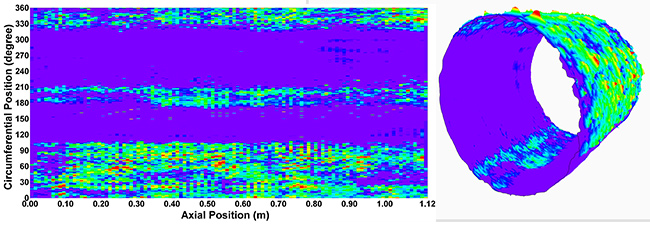
To assess internal and external corrosion in piping configurations that are unpiggable or otherwise difficult to assess, Structural Integrity Associates, Inc. (San Jose, California), a company specializing in the prevention and control of structural and mechanical failures, has developed a novel dynamic pulsed eddy current (PEC) technology, SIPEC†, that is integrated with the RODIS† robotic inline inspection (ILI) tool developed by Diakont (San Diego, California), a manufacturer of advanced robotics and inspection equipment. With the robotic crawler ILI tool as the delivery system, dynamic PEC is capable of internally inspecting metallic pipes with complex geometrical configurations and evaluating the remaining wall thickness of pipes that are either bare; lined with cement, polymeric, or other nonmetallic materials (e.g., wax and asphalt); or severely corroded or otherwise fouled. This new dynamic PEC technology can be used in the hazardous liquid, natural gas, petrochemical, water, and power generation industries.
The dynamic PEC technology detects defects in metallic pipes using electromagnetic induction. An excitation coil that carries an electrical current pulse is placed near the pipe surface, and the current flowing through this coil produces magnetic fields, which generate eddy currents that permeate the pipe wall and diffuse into the metal to various depths. The eddy current diffusion rate is a function of the material properties of the pipe and the wall thickness, and the variation in the diffusion rate alters the shape of the response signal. The origin of the wall loss (i.e., inside diameter [ID] or outside diameter [OD]) and magnitude is determined by analyzing various features of the response signals. The main advantage of dynamic PEC assessment is that wall thickness measurements of the pipe can be taken through insulation materials, coatings, and corrosion products, says Owen Malinowski, team leader of NDE development in the Research, Development, and
Integration Group at Structural Integrity Associates, Inc. The dynamic PEC probe isn’t required to be in direct contact with the metal surface of the pipe. Since the technique relies on the generation of eddy currents in the pipe wall, it only works on electrically conductive materials. Electrically nonconductive and nonmagnetic materials are essentially invisible to the probe, he adds.
Dynamic PEC assessment is most advantageous when inspection techniques requiring direct contact with a structure’s surface can’t be utilized because of insulation, liners, heavy surface roughness, corrosion, etc. Traditional PEC technology uses static, point-to-point inspection protocols on grids spaced several inches apart, where probes are moved from location to location and take wall thickness measurements from the OD of a pipe through the insulation. The probe is left in place for several seconds to make a single measurement.
According to Kamalu Koenig, Ph.D, senior engineer with Structural Integrity Associates, Inc., an inherent challenge in determining wall thickness loss with traditional PEC technology is distinguishing between the response signal for changes in probe liftoff and the response signal for loss in the structure’s wall thickness. Liftoff refers to the distance between the probe and the metallic surface of the pipe wall when the probe is separated from the internal surface of the pipe, which occurs when the probe passes over bumps or corrosion on the pipe wall or when the probe is separated from the pipe by insulation or a liner. The signal response due to changes in probe liftoff is similar in appearance to the signal response when wall loss or a defect is encountered.
Koenig explains that the response signal is a pulse defined by particular features, and the pulse shape changes depending on different factors. To differentiate between liftoff and pipe wall defects, the dynamic PEC technology analyzes selected features of the pulse that characterize whether the changes in the pulse’s shape result from wall loss or liftoff. He notes the pulse’s features that are dependent on probe liftoff are largely independent of wall thickness, which allows the technology to distinguish between the two. A recently completed probability of detection study produced probe performance specifications that are valid for pipe wall thicknesses up to 0.5-in (13-mm) and liners up to 0.625-in (15.8-mm) thick. The probe can take measurements through sludge and corrosion build-up as well.
Other advantages of the dynamic PEC technology include improved spatial resolution, improved signal-to-noise ratio, the ability to acquire data while the probe is in motion (dynamic data acquisition), and spatial characterization of anomalies (axial and circumferential). Combining the new dynamic PEC probe with the robotic crawler ILI tool enables the assessment technology to be used in many larger diameter pipe structures with unpiggable characteristics, such as tight radial bends, short runs, dimension changes, low-flow, single point access, unbarred tees, and linings, that make them difficult or impossible to inspect with conventional ILI tools.
Tyler Powell, engineering manager for Diakont, explains that the crawler’s traction system comprises two continuous tracks (also known as tank treads or caterpillar tracks) on its base for propulsion on horizontal surfaces, and a single continuous track attached to an actuator on top of the crawler so it can be extended out to push against the inside of the pipe wall for stabilization as well as provide the necessary adherence for holding the crawler rigidly in place while inspecting difficult pipe geometries such as vertical sections. An operator navigates the crawler through the pipe using real-time images that are transmitted back to the operator’s station from the robot’s five onboard cameras. Powell notes that the operator continually compares the robot’s location to schematics of the pipe so the operator knows the crawler’s exact position at all times during the inspection.

Two dynamic PEC probes are mounted on the crawler. Each probe has attached wheels and is connected to a rigid, mechanical arm that extends from the crawler. The probes directly contact
the internal surface of the pipe (or liner), and the design of the arms enables the probes to follow the contours of the curved surface. The two arms rotate, allowing each probe to sweep 180 degrees of the pipe circumference so the entire internal surface is assessed. After one section of the circumference is scanned, the crawler moves forward axially in set increments and the next section is scanned. Each probe takes up to 50 measurements per second while scanning at rates of up to 6 in/s (152 mm/s), and evaluating all of the internal pipe surface area is possible with grid spacing of a few tenths of an inch. The dynamic PEC probe is capable of detecting ID wall loss at <81% remaining wall thickness and OD wall loss at <68% remaining wall thickness with 90% probability of detection.
Collected probe data, along with the onboard camera images, the operator’s navigational instructions, and electrical power, are transmitted between the operator’s station and the crawler via a 1,500-ft (457-m) long umbilical cable. As the crawler moves through the pipe, data are transferred back to the operator station in real time and interpreted through accompanying software, which provides a dynamic color graphic display for the operator that refreshes in real time as the inspection progresses. The display shows
the axial pipe position and the corresponding circumference in degrees, and color is used to illustrate degrees of wall thickness loss.
Currently, the dynamic PEC/crawler technology is able to support inspections for piping with diameters of 24 to 55 in (0.6 to 1.4 m). The crawler can be inserted into any access opening (e.g., a removed valve or flange, or a cut spool) that is at least 22 in (0.5 m) wide. In August 2014, the technology was successfully demonstrated on site in an operator’s 36- and 42-in (0.9- to 1.1-m) diameter test spools. The system was able to detect ID and OD defects through an internal fiberglass liner on the test spool, where the probe liftoff was ~0.625 in (15.9 mm) for the 42-in diameter test spool and 0.600 in (15.2 mm) on the 36-in diameter test spool. Concave and flat bottom defects were accurately detected and defect depth measurements were within 0.056 in (1.4 mm) of the actual identified defect depths. All defect depth measurements were within ±15% of the nominal wall thickness.
Contact Kamalu Koenig, Structural Integrity Associates, Inc.—e-mail: kkoenig@structint.com; Owen Malinowski, Structural Integrity Associates, Inc.—e-mail: omalinowski@structint.com; and Tyler Powell, Diakont—e-mail: tpowell@diakont.us.com
†Trade name.